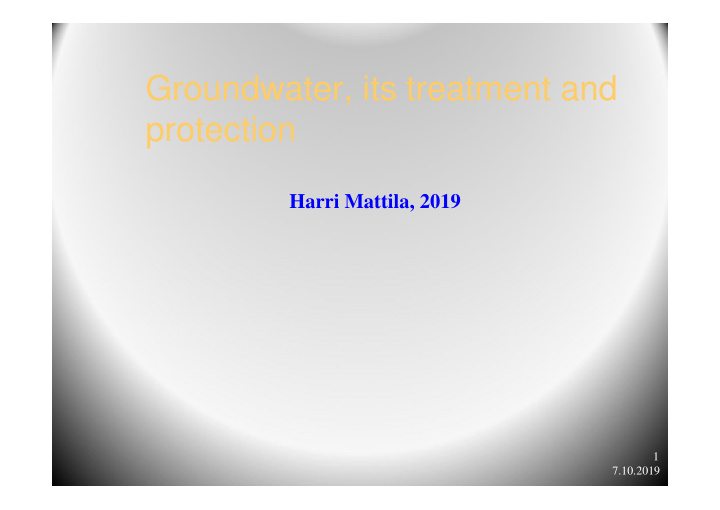



Groundwater, its treatment and protection Harri Mattila, 2019 1 7.10.2019
General l Groundwater forms only 0,53 % of all water resources (worldwide). l In Finland, more than 2/3 of all raw water is groundwater or artificial groundwater l Advantages of groundwater when compared to surface water: - No need for disinfection (in normal situations) - Temperature is rather constant (and low) - Little or no chemicals involved in treatment 2 7.10.2019
The hydrological cycle 3 7.10.2019
Various groundwater formations 4 7.10.2019
Observation tube (well) l Usually PVC pipe l DN > 50 mm l Screen in the depth of the groundwater layer 5 7.10.2019
An example of groundwater depth variations (Tuusula, Finland) 6 7.10.2019
The need for groundwater treatment l optimum situation: no treatment l most common reason is prevention of corrosion l Fe or Mn l organic material l fluoride l salts l radon l arsenic 7 7.10.2019
pH -value l Depends on soil around the groundwater well l Sometimes rain water can be acidic l pH of groundwater in Finland is normally between 5 - 7 8 7.10.2019
Nitrate compounds l ammonium, nitrate, nitrite, nitrogen l Very rarely in Finnish groundwaters l Usually means pollution by agriculture or industry l Sometimes also because of wastewater in groundwater! 9 7.10.2019
Sulfate l Can be diluted in groundwater for example from minerals rich of sulphur beacause of high pH. l Important factor in corrosion l limit 50 mg/l 10 7.10.2019
Iron and manganese l Most common problems in groundwater (in Finland) l No health hazard – technical and/or aesthetical problems l Fe < 0,2 mg/, Mn < 0,05 mg/l l Causing also sedimentation in networks and that’s why harmful 11 7.10.2019
Chloride l Normally because of nearby sea but also because of deicing in winter l In nature < 10 mg/l, taste limit 200 – 300 mg/l, recommended maximum 250 mg/l, target 25 mg/l l Very important factor in corrosion 12 7.10.2019
Hardnes l Ca- ja Mg –salts l 1 mmol/l = 5,6 º dH l Should be 3 – 5 º dH l The most interesting parameter to customers due to washing machines l sometimes high also in Finland, even >10 13 7.10.2019
Aluminium l Can be diluted from from the soil (like Fe and Mn), specially when the soil in acidic l The maximum limit allowed 0,2 mg/l 14 7.10.2019
Arsenic l carcinogenic, max allowed 0,01 mg/l l Mainly in deep boreholes l In Finland about 7% of all the deep wells are contaminated 15 7.10.2019
Boron l Max allowed 1,0 mg/l l Is indicating pollution by wastewater l Appears very seldom 16 7.10.2019
Fluoride l WHO: max allowed 1,5 mg/l (note, drinking water should have 0,5 mg/l) l Defluoridation is considered as an expensive task => 1. change the source if possible, 2. dilute water with another one with little flouride, 3. treatment 17 7.10.2019
Copper l Max allowed 2,0 mg/l ( an average / week) l Rather seldom in groundwater l Mainly because of corrosion in pipelines 18 7.10.2019
Bacteria l E.coli is the most important indicator 19 7.10.2019
Viruses l Very difficult to analyze => difficult to separate/destroy from water 20 7.10.2019
Dilutants l Altogether about 70 compounds l Hydrogarbons, alcohols, aethers, esters, aldehydes, ketones 21 7.10.2019
MTBE, TAME l Additives in petrol l Are diluted very easily in water => the first compounds found in case of pollution l Easy to detect by smell and taste (0,03 mg/l) 22 7.10.2019
Pesticides l Hundreds of compounds l Max allowed 0,0005 mg/l (total) l The smallest amounts which can be detected are normally 0,00001 – 0,00002 mg/l 23 7.10.2019
Radioactivity l Mostly in deep wells (in the rock) l No smell, no colour, no taste ! l Radon is the most common one in groundwater l Max allowed 1000 Bq/l) => 1. new water source, 2. treatment (aeration, active carbon filtration) 24 7.10.2019
Uranium l Lack of knowledege concerning health effects l Earlier max by WHO 0,15 mg/l, today 0,002 mg/l 25 7.10.2019
Corrosion l pH > 7,5 l alkalinity > 0,6 mmol/l l calsium > 10 mg/l l oxygen > 2 mg/l 26 7.10.2019
Maps and aerial photographs l Swamps, springs, ditches, etc. l Humidity changes out of photgraphs l Old maps might give valuable information 27 7.10.2019
Geophysical methods l Seismic sounding l Electrical probing (resistance) 28 7.10.2019
Drillings l Manually l Machinery 29 7.10.2019
Iron and manganese l Most common quality problem with ground waters l Coagulation happens immediately with ozygen l Iron can be removed also biologically 30 7.10.2019
Removal of Fe and Mg l In small scales – aeration – sand filtration – ion exchange processes l Lime stone filtration l Slow sand filtration 31 7.10.2019
Slow sand filtration l Water is filtered slowly through a sand layer l Surface load 0,05 – 0,2 m/h l Water per one 1 m2: 50 – 200 l/h l Iron content max 1mg/l l Pretreatment could be done by a filter containing crushed stone 32 7.10.2019
Sand filtration l Aeration needed almost always l Dissolved iron is oxidized => can be filtered out of water l Surface load normally 4 – 5 m/h l Small filters require backwashing more often l Might be expensive ? 33 7.10.2019
UV desinfection l Generally, ground water is microbiologically clean l Sometimes we have experienced pollution l UV-desinfiction is applicable method for ground waters (no turbidity nor colour) l UV-desinfection is not affecting the taste of water unlike chlorination 34 7.10.2019
Ground water protection ! 35 7.10.2019
Raato 36 7.10.2019
Recommend
More recommend